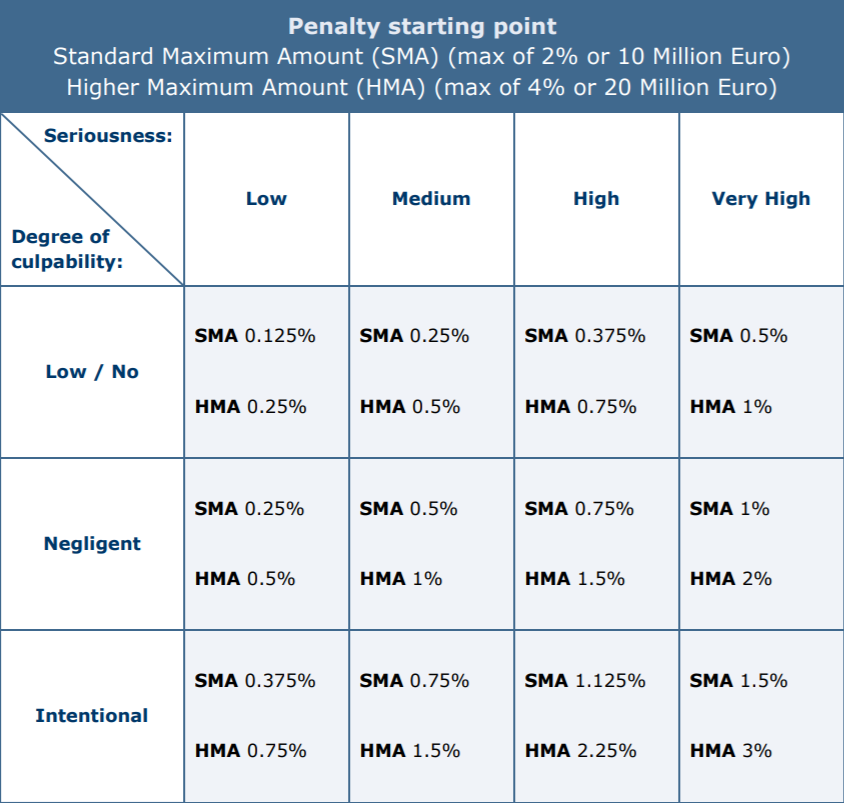The Information Commissioner’s Office in the UK (the “ICO”) has published for consultation its draft statutory guidance setting out how it will regulate and enforce data protection legislation in the UK.
The document explains all of the ICO’s key powers (including information notices, assessment notices, enforcement notices and penalty notices). Perhaps most interestingly for organisations, it also sets out for the first time, the ICO’s approach to how it calculates fines under the GDPR, giving organisations a better sense of the level of fine to which they could be subject for GDPR non-compliance.
However, although the ICO has provided a table setting out it’s ‘starting point’ for the calculation of fines, there is nonetheless a large amount of discretion that the regulator can apply to adjust the fine both upwards and downwards, meaning that the process is not as transparent as it may at first seem.
Although the fine calculator is only in draft form at this stage, it is the first time that the process adopted by the ICO has been made public. Responses to the consultation are required by 5pm on Thursday 12 November 2020.
GDPR fine calculator
The ICO’s draft guidance sets out nine steps which will factor into the calculation of a fine for non-compliance with the GDPR, including seriousness, culpability, aggravating and mitigating factors, economic impact and dissuasiveness.
These steps will be applied to all GDPR fines, regardless of whether the so-called ‘standard maximum amount’ or ‘higher maximum amount’ applies. As per the GDPR, the higher maximum amount is €20 million or 4% of annual worldwide turnover (whichever is greater). The standard maximum amount is €10 million or 2% of annual worldwide turnover (whichever is greater).
The following three steps will be considered initially in order to enable the ICO to identify its ‘starting point’:
Seriousness
The factors to consider when assessing the seriousness of any infringement reflect those set out in the GDPR, including the nature, gravity, and duration of the failure; any action taken by the data controller or processor to mitigate the damage suffered by data subjects; the degree of cooperation with the ICO; and the way the breach became known to the ICO, including whether the data controller or processor notified the ICO of the failure.
Culpability
When assessing culpability, the ICO will take into account the intentional or negligent character of the failure; specifically whether the organisation was intentional or negligent about its responsibility for the breach.
Turnover
The ICO will review relevant accounts and obtain expert financial, or accountancy advice if required, to determine the amount of turnover (or equivalent for non-profit organisations such as the annual revenue budget and the financial means of individuals).
In circumstances where turnover or equivalent is minimal, the ICO will give greater weight to other factors such as dissuasiveness, particularly where there is a serious breach. Where there is a lack of cooperation in providing all relevant financial information, the panel will rely on the information available or otherwise give greater weight to factors such as aggravating features.
Starting point
Once the factors above have been assessed, the helpful table below sets out the ‘starting point’ for the fine, stated as a percentage of annual worldwide turnover, against which various other factors will be applied:

Once the appropriate starting point has been identified, the ICO will then apply the following other factors in order to adjust the starting point and reach the final level of the fine:
Aggravating and mitigating factors
The ICO will consider any aggravating and mitigating factors applicable to the circumstances of the case, such as financial benefits gained, or losses avoided, directly or indirectly, from the breach.
When determining the amount of any proposed administrative fine, the ICO will then adjust the starting point figure for each band accordingly, upwards or downwards, to reflect its assessment of applicable aggravating or mitigating circumstances. It will clearly record which aggravating and mitigating features it has taken into account and why and how it considers that these influence the proposed administrative penalty.
Financial means
The ICO will consider the likelihood of the organisation or individual being able to pay the proposed penalty and whether it may cause undue financial hardship.
Economic impact
The ICO will, where appropriate, consider any economic impact on the wider sector, or related regulatory impact of the proposed penalty beyond the organisation or individuals it is serving the penalty on.
Effectiveness, proportionality and dissuasiveness
The ICO will ensure that the amount of the fine proposed is effective, proportionate, and dissuasive and will adjust it accordingly.
Early payment discount
The ICO will reduce the monetary penalty by 20%, if it receives full payment of the monetary penalty within 28 calendar days of sending its final penalty notice. However, this early payment discount is not available if the controller decides to exercise its right of appeal to the First-tier Tribunal.
Key contacts
Disclaimer
The articles published on this website, current at the dates of publication set out above, are for reference purposes only. They do not constitute legal advice and should not be relied upon as such. Specific legal advice about your specific circumstances should always be sought separately before taking any action.
